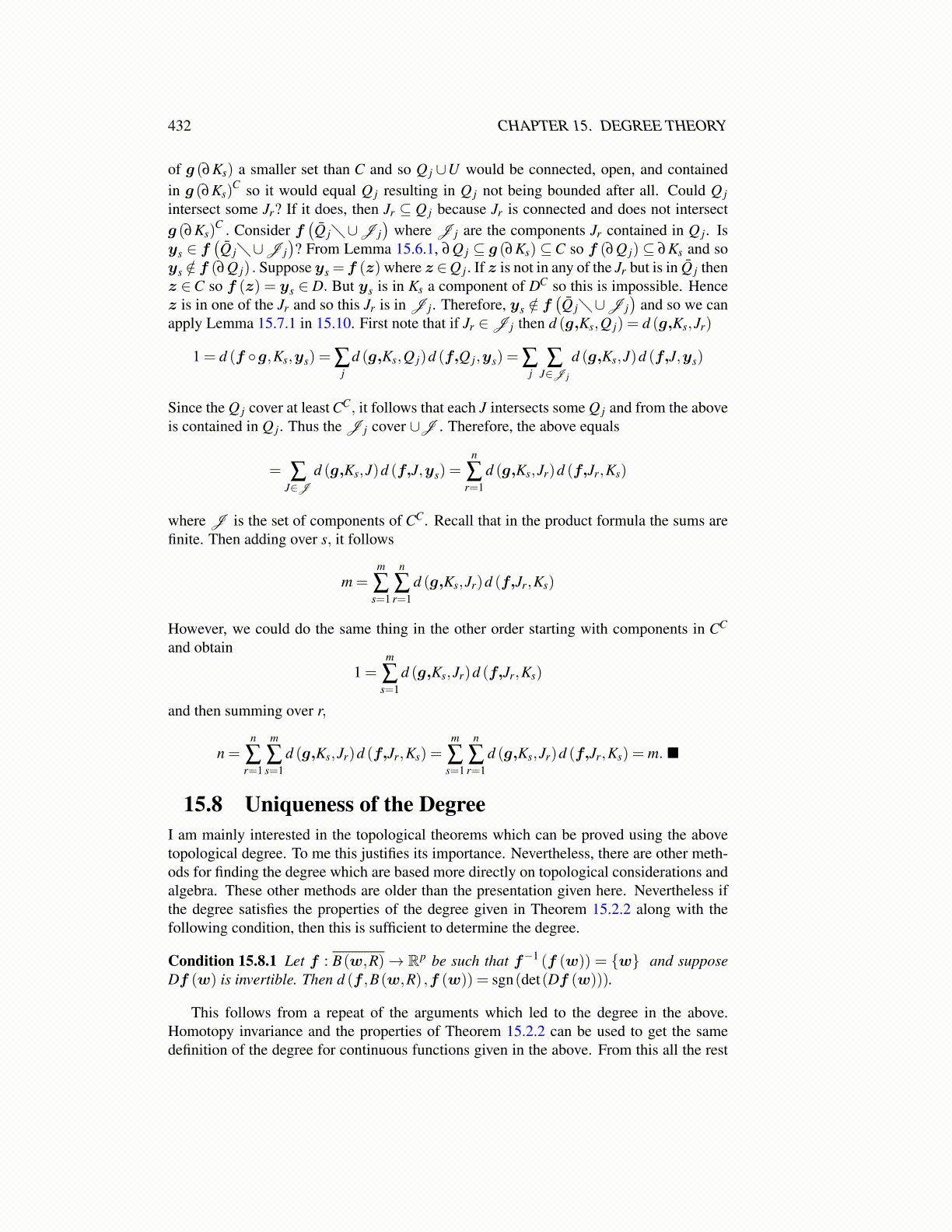
432 CHAPTER 15. DEGREE THEORY
of g (∂Ks) a smaller set than C and so Q j ∪U would be connected, open, and containedin g (∂Ks)
C so it would equal Q j resulting in Q j not being bounded after all. Could Q jintersect some Jr? If it does, then Jr ⊆ Q j because Jr is connected and does not intersectg (∂Ks)
C . Consider f(Q̄ j⧹∪J j
)where J j are the components Jr contained in Q j. Is
ys ∈ f(Q̄ j⧹∪J j
)? From Lemma 15.6.1, ∂Q j ⊆ g (∂Ks) ⊆C so f (∂Q j) ⊆ ∂Ks and so
ys /∈ f (∂Q j) . Suppose ys = f (z) where z ∈Q j. If z is not in any of the Jr but is in Q̄ j thenz ∈C so f (z) = ys ∈ D. But ys is in Ks a component of DC so this is impossible. Hencez is in one of the Jr and so this Jr is in J j. Therefore, ys /∈ f
(Q̄ j⧹∪J j
)and so we can
apply Lemma 15.7.1 in 15.10. First note that if Jr ∈J j then d (g,Ks,Q j) = d (g,Ks,Jr)
1 = d (f ◦g,Ks,ys) = ∑j
d (g,Ks,Q j)d (f,Q j,ys) = ∑j
∑J∈J j
d (g,Ks,J)d (f,J,ys)
Since the Q j cover at least CC, it follows that each J intersects some Q j and from the aboveis contained in Q j. Thus the J j cover ∪J . Therefore, the above equals
= ∑J∈J
d (g,Ks,J)d (f,J,ys) =n
∑r=1
d (g,Ks,Jr)d (f,Jr,Ks)
where J is the set of components of CC. Recall that in the product formula the sums arefinite. Then adding over s, it follows
m =m
∑s=1
n
∑r=1
d (g,Ks,Jr)d (f,Jr,Ks)
However, we could do the same thing in the other order starting with components in CC
and obtain
1 =m
∑s=1
d (g,Ks,Jr)d (f,Jr,Ks)
and then summing over r,
n =n
∑r=1
m
∑s=1
d (g,Ks,Jr)d (f,Jr,Ks) =m
∑s=1
n
∑r=1
d (g,Ks,Jr)d (f,Jr,Ks) = m. ■
15.8 Uniqueness of the DegreeI am mainly interested in the topological theorems which can be proved using the abovetopological degree. To me this justifies its importance. Nevertheless, there are other meth-ods for finding the degree which are based more directly on topological considerations andalgebra. These other methods are older than the presentation given here. Nevertheless ifthe degree satisfies the properties of the degree given in Theorem 15.2.2 along with thefollowing condition, then this is sufficient to determine the degree.
Condition 15.8.1 Let f : B(w,R)→ Rp be such that f−1 (f (w)) = {w} and supposeDf (w) is invertible. Then d (f ,B(w,R) ,f (w)) = sgn(det(Df (w))).
This follows from a repeat of the arguments which led to the degree in the above.Homotopy invariance and the properties of Theorem 15.2.2 can be used to get the samedefinition of the degree for continuous functions given in the above. From this all the rest